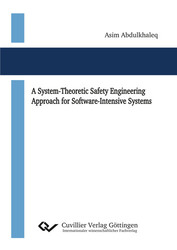| Departments | |
|---|---|
| Book Series (96) |
1378
|
| Nachhaltigkeit |
3
|
| Gesundheitswesen |
1
|
| Humanities |
2365
|
| Natural Sciences |
5406
|
| Mathematics | 229 |
| Informatics | 319 |
| Physics | 980 |
| Chemistry | 1363 |
| Geosciences | 131 |
| Human medicine | 243 |
| Stomatology | 10 |
| Veterinary medicine | 108 |
| Pharmacy | 147 |
| Biology | 835 |
| Biochemistry, molecular biology, gene technology | 121 |
| Biophysics | 25 |
| Domestic and nutritional science | 45 |
| Agricultural science | 1004 |
| Forest science | 201 |
| Horticultural science | 20 |
| Environmental research, ecology and landscape conservation | 148 |
| Engineering |
1793
|
| Common |
98
|
|
Leitlinien Unfallchirurgie
5. Auflage bestellen |
|
Advanced Search
A System-Theoretic Safety Engineering Approach for Software-Intensive Systems (English shop)
Asim Ali Ahmed Abdulkhaleq (Author)Preview
Extract, PDF (140 KB)
Table of Contents, PDF (50 KB)
Software safety is a crucial aspect during the development of modern safety-critical systems. However, safety is a system level property, and therefore, must be considered at the system-level to ensure the whole system’s safety. In the software development process, formal verification and functional testing are complementary approaches which are used to verify the functional correctness of software; however, even perfectly reliable software could lead to an accident. The correctness of software cannot ensure the safe operation of safety-critical software systems. Therefore, developing safety-critical software requires a more systematic software and safety engineering process that enables the software and safety engineers to recognize the potential software risks. For this purpose, this dissertation introduces a comprehensive safety engineering approach based on STPA for Software-Intensive Systems, called STPA SwISs, which provides seamless STPA safety analysis and software safety verification activities to allow the software and safety engineers to work together during the software development for safety-critical systems and help them to recognize the associated software risks at the system level.
| ISBN-13 (Hard Copy) | 9783736994928 |
| ISBN-13 (eBook) | 9783736984929 |
| Final Book Format | A5 |
| Language | English |
| Page Number | 220 |
| Lamination of Cover | matt |
| Edition | 1. Aufl. |
| Publication Place | Göttingen |
| Place of Dissertation | Stuttgart |
| Publication Date | 2017-02-23 |
| General Categorization | Dissertation |
| Departments |
Informatics
|
| Keywords | STPA, Software Safety, Safety Verification, Model Checker, Test Case Generating, XSTAMPP, Risk-based Testing |








